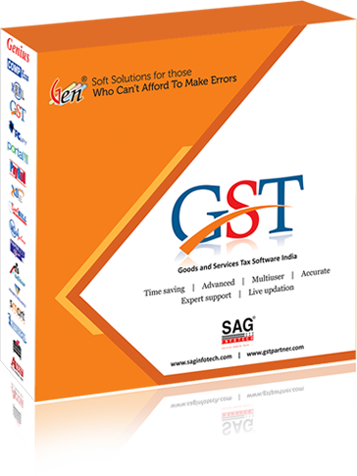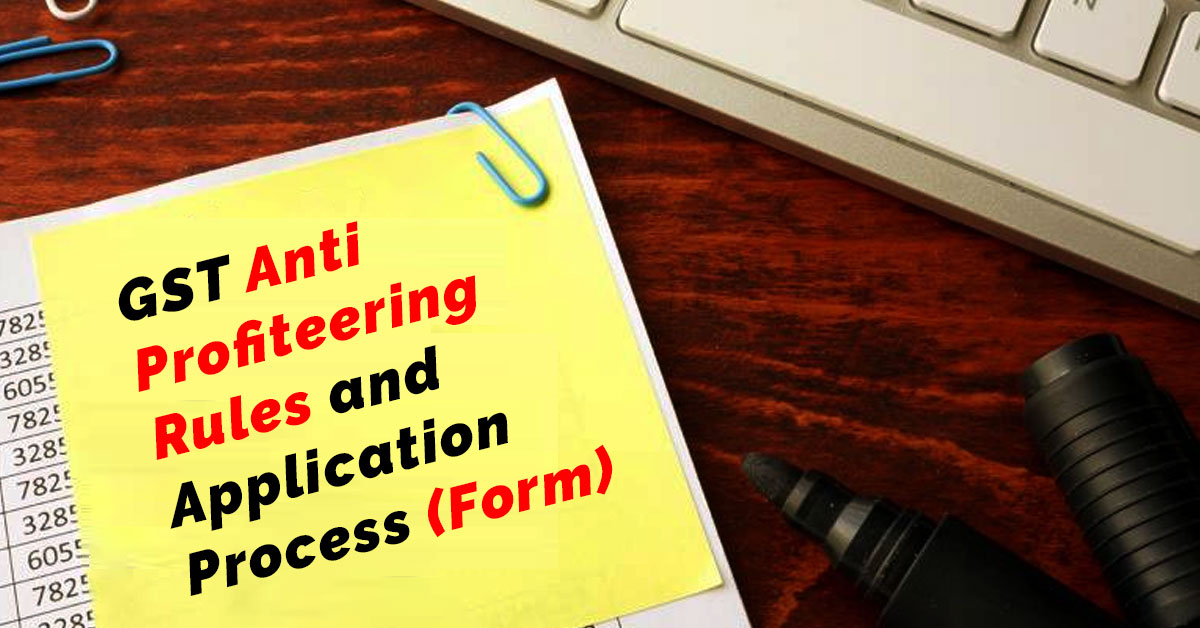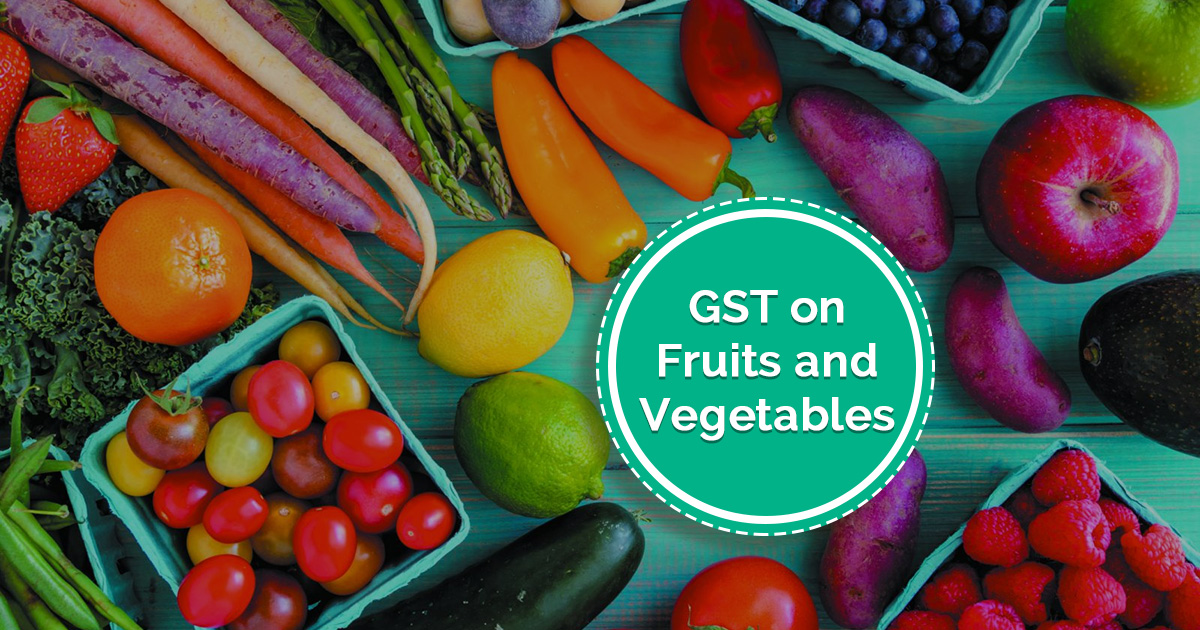The Indian government has officially released the GST anti-profiteering rules and application form (APAF-1), which can be used by consumers for filing a complaint against any business or dealer who is not passing on GST benefits to his consumers. An anti-profiteering committee has been established for the purpose whose sole job will be to look into such complaints and provide timely solutions to make sure that GST benefits are properly passed on by all taxpayers to the end consumers.
Contents
GST Anti Profiteering Rules
The Anti-Profiteering committee will decide on some rules and guidelines to make sure that the GST benefits, in the form of low tax rates and input tax credits, reach the end consumers.
Anti-Profiteering Application Form and Filing Process
The consumer who wants to file a complaint will have to provide details, like sale price (before and after GST), tax (before and after GST) on specific goods/services, benefits from input credit, etc., in their application form.
The application form has only column for one product/service, so the applicant may have to file separate applications for each product or service.
After the implementation of GST in India, the rate of some goods and services was expected to go down because of lower GST rates and the benefit of input credit, however, many dealers and businesses are reluctant to pass on such benefits to their consumers in the form of price reductions on their supplies. The Anti-Profiteering committee was established to tackle such things.
Anti-Profiteering Application Form (APAF-1) Format
Anit profiteering form contains four tables as following:
A. General Information about the Applicant
B. General Information about the supplier
C. Particulars of Goods/Services
D. Details of reduction in tax rate and benefits of ITC
Instructions for filing the GST Anti-Profiteering Form
Follow the points mentioned below when filing the form.
- Be sure to attach the self-attested copies of all proof documents, including invoices, proof of identity, bills, details working sheet, etc.
- Pre-GST refers to the period before the launch of GST and pro-GST is for activities that happen after GST implementation.
- The application is to be strictly filed only in BLOCK (CAPITAL) LETTERS.
- The meanings of various terms used in this form.
- GSTIN: Goods and Services Tax Identification Number assigned to a GST registered taxpayer.
- CGST: Central GST
- SGST: State GST
- UTGST: Union Territory GST
- IGST: Integrated GST
- HSN: Harmonized System Nomenclature for taxable products
- SAC: Service Accounting Code
- One application form can only be used to provide details of a single product/service. Separate forms will be used for each good/service.
- An application will be treated as valid only if it has all the required documents and invoices attached to it.
- The completed application (in pdf format) is to be sent to
- State level screening committee – for local/state region issues – at the address (for specific state) mentioned at URL: goo.gl/eYJXnK
- Central Standing Committee – for out of state issues – at 2nd Floor, Bhai Vir Singh Sahitya Sadan, Bhai Vir Singh Marg, Gole Market, New Delhi-110 001. Tel No.: 011-23741537 (Fax. No.: 23741542, E-mail: anti-profiteering@gov.in)
- If the details provided by an applicant in his/her application are not sufficient, they may be asked for additional details by the committee.
Process for filing Anti-Profiteering Application Form
First, you have to download the application form by using this link:
Then, take a print out of the pdf file.
Fill in the form as per the instructions given below.
There are four tables in the application form.
A. General information about the applicant: The applicant has to provide his own information, including his name, code of applicant, GST registration number (if any), and proof of identity.
A.1* – Name: This field will contain the name of the recipient as given in the proof of identity attached with the application form.
A.2* – Code of Applicant: Selected the right code depending on whether you are,
- 01 Interested party+ (suppliers or recipients of goods/services)
- 02 Commissioner
- 03 Any other person
A.3 – GST Registration No.: The 15-digit GST registration number of the applicant.
A.4 – Address of the applicant
A.5 – Contact Number of the applicant
A.6 – Email Id of the applicant
A.7* – Proof of Identity – Select the code for the proof of identity (from following options) that you are going to attach to this form.
- 01 Aadhaar Card issued by the Unique Identification Authority of India
- 02 Voter ID
- 03 Permanent Account Number (PAN) card
- 04 Driving Licence
- 05 Passport
- 06 Ration card having photograph of the applicant
- 07 Any other proof of Identity (Specify)
B. General Information about the Supplier (who has not passed on the benefit): Details like the name and code of the guilty supplier.
B.1* – Name: Enter name of the supplier as mentioned in the supporting documents like Invoice etc.
B.2*: Code of Supplier: Choose a code depending on whether the supplier is:
- 01 Manufacturer
- 02 Service Provider
- 03 Trader
- 04 Others (Specify)
B.3* – Address of the supplier
B.4* GST Registration No. (GSTIN) of the supplier
B.5 Contact Number of the supplier
B.6 Email ID of the supplier
B.7 Website address of the supplier, if any.
C. Particulars of Goods/Services: This column will be used to provide the following details of the goods and services for which application is being filed.
C.1* Description: Mention the type or nature of goods/services as mentioned in invoice/price list etc.
C.2 HSN/SAC: Provide the right HSN code for the product or SAC code for the service, as mentioned in the invoice or price list.
C.3* Actual Price/Value charged per unit Pre-GST: Mention the actual price per unit of the product/service (after any applicable discount) as in the pre-GST regime.
C.4* Actual Price/Value charged per unit Post-GST: Mention the actual price per unit of the product/service (after any applicable discount) as in the post-GST regime.
C.5 – If Goods are covered under MRP Provisions
- C.5a – MRP Pre-GST: Enter the MRP of the product/service before GST, as printed on the pack.
- C.5b – MRP Post-GST: Provide the MRP of the product/service after GST, as printed on the pack of the same quality.
C.6 – Comparative per unit actual Price/Value of like Goods/Services charged by other supplier: If any other supplier is selling the same product/service at lower rate, provide the name and GSTIN of that supplier along with –
- C.6a – Pre-GST: The actual price per unit of the similar or same product/service (after considering any applicable discount) as in the pre-GST regime.
- C.6b – Post-GST: The actual price per unit of the similar or same product/service (after considering any applicable discount) as in the post-GST regime.
D. Details of reduction in Tax rate/ benefit of Input Tax Credit: Mention the details of whether the tax rate on particular product//service was reduced after GST and by how much or if the commodity is benefitted from input tax credit.
D.1 – Particulars of Taxes on output Goods/Services, including the rate of tax, per unit price of the commodity (value for tax), and the amount of tax on per unit.
D.2 – Taxes Pre GST (Earlier Tax Rate): Mention the rate of indirect taxes (such as Excise Duty, Value Added Tax, Central Sales Tax, Luxury Tax, Service Tax, Cesses (including compensation cess) and other taxes) applicable on the product/service in the pre-GST regime. Also mention the base (taxable) price per unit of the product/service, and the effective pre-GST tax applicable to per unit of the commodity.
D.3 – Total tax per unit: Calculate the total tax applicable to per unit of goods/services, before GST, by adding all the above taxes.
D.4 – Taxes Post GST (Later Tax Rate): Mention the rate of indirect taxes (such as CGST, SGST/UTGST, IGST, compensation cess and other cesses and taxes) applicable on the product/service in the post-GST regime. Also mention the base (taxable) price per unit of the product/service, and the effective pre-GST tax applicable to per unit of the commodity.
D.5* – Total Tax Per Unit: Calculate the total tax applicable to per unit of goods/services, after GST, by adding all the above taxes.
D.6* – Post-GST reduction in amount of tax per unit: Calculate the reduction in the amount of tax per unit of the commodity, by subtracting total tax post-GST (D.5) from total tax pre-GST (D.3).
D.7 – Input Taxes/Duties Pre-GST per unit, credit of which was not available (out of the Taxes/Duties subsumed in GST). Attach working sheets: Mention the calculation computation of the Input Taxes/Duties Pre-GST per unit, credit of which was not available to the supplier before implementation of GST and attach working sheets for the same (out of the Taxes/Duties subsumed in GST). The illustrative list is given below:
a. Central Excise duty
b. Duties of Excise (Medicinal and Toilet Preparations)
c. Additional Duties of Excise (Goods of Special Importance)
d. Additional Duties of Excise (Textiles and Textile Products)
e. Additional Duties of Customs (commonly known as CVD)
f. Special Additional Duty of Customs (SAD)
g. Service Tax
h. Central Surcharges and Cesses so far as they relate to supply of goods and services
i. State VAT
j. Central Sales Tax
k. Luxury Tax
l. Entry Tax (all forms)
m. Entertainment and Amusement Tax (except when levied by the local bodies)
n. Taxes on advertisements
o. Purchase Tax
p. Taxes on lotteries, betting and gambling
q. State Surcharges and Cesses so far as they relate to supply of goods and services.
It should not include details of Taxes/Duties, credit of which was available prior to GST. Provide information only in respect of Input Taxes/Duties, credit of which was not available to the supplier before implementation of GST.
Also, specify Transitional Input Tax Credit availed in terms of Section 140(3) of CGST Act, 2017 read with Rule 117 of CGST Rules, 2017 which is not passed on to the recipient.
D.8 – Difference (+/-) between Post-GST and Pre-GST actual price/value charged per unit: Calculate the change in the per unit price of the commodity by subtracting the per unit price pre-GST (C.3) from per unit price post-GST (C.4).
D.9 – Amount of benefit not passed on after adjusting difference between Post-GST and Pre-GST actual price/value: Calculate the amount of benefit, which supplier was supposed to pass on to the customer, by adding the reduction in tax per unit post-GST (D.6) and the post-GST benefit of input credit per unit on inputs (D.7) and the difference between post-GST and pre-GST price per unit of the commodity.
D.10 – GST on amount of benefit not passed on: Calculate the GST applicable on the amount of benefit not passed on by multiplying the amount of benefit (D.9) and the percentage GST rate (D.5).
D.11 – Post-GST per unit price/value to be reduced by: Mention the per unit price/value to be reduced from the actual price charged per unit of commodity post-GST, by adding D.9 and D.10.
D. 12 – Additional information, if any: Mention here any other information you want to provide regarding the form or complaint.
Make sure to provide applicant signature in the declaration at the bottom of the form.
After finishing the form, the application form along with all the required documents, including invoices, proof of identity, etc., is required to be sent to the addresses mentioned above.






